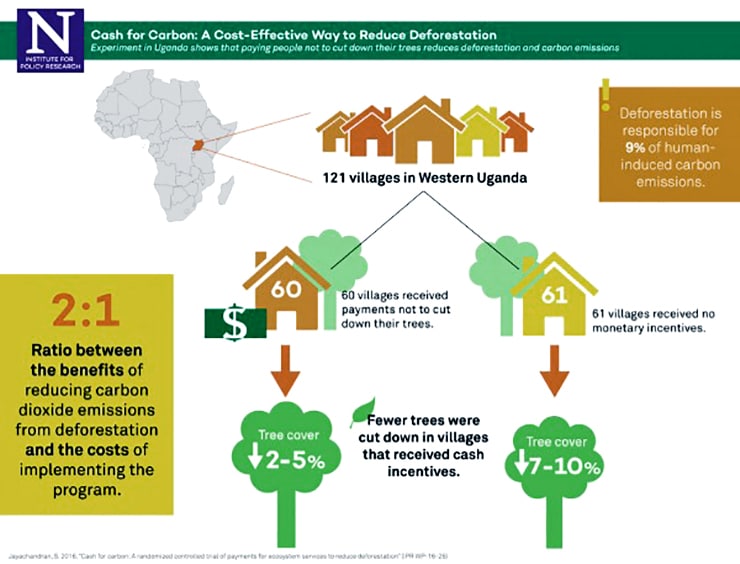Paying people to conserve trees may be a cost-effective way to curb deforestation and reduce carbon emissions and should be a key component of fighting climate change, a new study suggests.
The study sought to evaluate how effective “Payments for Ecosystems” (PES) is at reducing deforestation. PES is a program in which people receive financial rewards for pro-environment behaviors.
In the study, people who owned forest in 60 villages in western Uganda received cash rewards if they kept their forest intact and refrained from deforesting it. Forest owners in another 61 villages in western Uganda received no monetary incentives.

“We found that the program had very large impacts on forest cover,” says Seema Jayachandran, associate professor of economics in the Weinberg College of Arts and Sciences at Northwestern University and a faculty fellow with the university’s Institute for Policy Research.
“In the villages without the program, 9 percent of the tree cover that was in place at the start of the study was gone by the end of it, two years later. In the villages with the PES program, there was 4 to 5 percent tree loss. In other words, there was still deforestation, but much less of it,” she says.
“It wasn’t the case that only forest owners who were planning to conserve anyway enrolled,” Jayachandran says. “The payments changed people’s behavior and prompted them to conserve. And we didn’t find any evidence that they simply shifted their tree-cutting elsewhere. This truly was a net increase in forest cover in the study region.”
The first of its kind, the study applies the method of field experiments, or randomized controlled trials, to the question of how effective PES is. The study design helped the researchers accurately measure the averted deforestation caused by the program.
The best (and worst) ways to stop deforestation
Jayachandran says the cost effectiveness of the program compared to other approaches to reduce carbon emissions, such as subsidies for hybrid or electric vehicles in the United States, was eye opening.
“A major contribution of the study was to compare the benefit of reduced deforestation to the cost of the program. What’s that extra forest worth to society? We do that by applying what’s called the ‘social cost of carbon,'” Jayachandran says.
“This is an estimate that others have come up with for the economic damage to the world from each ton of CO2 that is emitted. We found that the benefit of the delayed CO2 emissions was over twice as large as the program costs. For many other environmental policies, the value of the averted CO2is in fact smaller than the program costs.”
The findings highlight the advantages of focusing on developing countries when working to reduce global carbon emissions. While the benefit of conserving a tree is the same regardless of the location, paying individuals to conserve forests in developing countries like Uganda is less expensive, making it cheaper to reduce overall emissions.
Paying farmers not to farm saved sage grouse
Today, with deforestation accounting for a substantial portion of human-induced carbon emissions, the researchers describe the payment program they studied as “a cost-effective way to avert deforestation in developing countries—and hence a powerful tool to mitigate climate change.”
The study appears in the journal Science. Additional coauthors are from Porticus, Amsterdam, Netherlands; Stanford University; the Carnegie Institution for Science; and the University of California, Berkeley.
Source: Northwestern University



